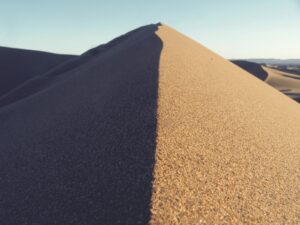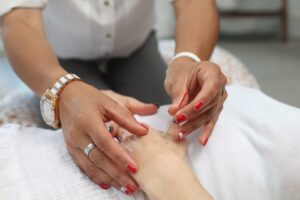Subscribe to the Newsletter
If you are interested in understanding how Traditional Chinese Medicine can improve your life sign up to my newsletter for the latest updates.

Jing-Well points are acupuncture points lying at the extreme limits of acupuncture channels, at the finger tips and toe tips. They are the first type of what are called ‘Shu-stream’ or ‘transport’ points.
If you’ve arrived on this page, which is about a clinically useful but somewhat obscure bit of Chinese medicine acupuncture practice, you were perhaps looking for something different, but found yourself wafted here by an overenthusiastic search engine.
For example,if you just want to find out about acupuncture, this page is not the place to start! Try this link.
Otherwise read on for information you didn’t know you needed and can easily soon forget – unless you’re an acupuncture student, of course, when it might be just what you require.
So, if you’ve decided to plough on, do realise that this site is all about balancing Yin and Yang. It mainly explains how to do this using acupuncture although other ways are mentioned too.
‘Qi’ is far more than just a concept in Chinese medicine. To Western-trained scientists and doctors it does not exist because disease can be explained in other ways and Qi cannot be weighed, measured or examined under a microscope.
However, to practitioners in practice it is very real. Whether or not it actually exists is to many of them beside the point. By using Qi as if it exists they can theorise about it and treat ill people with Qi medicine.
In a way it is like mathematics. You can study the theory of mathematics, read books about it, use it, see buildings built and rockets sent round the moon using mathematical calculations. But can you actually see or touch a piece of mathematics? (Apart from its description or pictures on a page!)
Quite. So too, for Qi.
How Qi behaves in its many ways has been the subject of intense thought by Chinese medicine practitioners and scholars for perhaps 3000 years, although their written texts don’t go back quite so far.
These jing-well points discussed on this page tend to be used in situations of excess although that isn’t their only use. Specifically, the problem is usually Yang Excess but they could be used for Yin Excess too, although probably with the addition of other points.
At the finger and toe tips, Qi is at its most yang, being the furthest from the centre.
Let me explain. Yang things are – in relation to Yin things – more ephemeral. They don’t last so long. They move and transform more easily.
You can lose bits of Yang eg your fingers, without endangering your Yin body. (Well, obviously there would be many repercussions, but assuming you don’t bleed to death and your skin heals over, your body will not have lost a vital part of its functioning. Its resilience remains intact.)
The muscles in your fingers and toes are weaker than those in your arms and legs.
That doesn’t mean that your Yang areas are less powerful! Your fingers wield the pen, (“…mightier than the sword”), pull the trigger and play music.
(Yes. I know some instruments only work if you blow them, but you still have to hold and manipulate them for music to appear.)
Also, the universe started, we are told, from one thing which seems to have been very small – but it had a lot of Qi. The outworking of that Qi is what we experience and which experiences itself as us.
So, to be more practical, at your toe and fingertips is where yang manifests before it starts to gets down and dirty along your acupuncture channels on its way into your body.
These points can dissipate excess yang pressure, or stimulate its movement when stuck or deficient.
Have you ever scalded a finger? You probably moved faster than you could think. A reflex reaction. Someone with less sensitivity moves more slowly and might, if there was numbness, not react, an unnatural reaction. The right treatment would bring sensation back to the fingertips.
What kind of excess yang pressure is there?
Glitches could include yang boiling over – mentally – and obstruction from an effervescence of Qi, like froth on boiling water. Take an analogy:
Water circulating in central heating systems circulates smoothly up to a certain temperature where it forms steam. At and above that temperature the water-pump revs uncontrollably until cooler, non-boiling water takes its place and the pump’s speed gets back to normal. When revving highly because of the steam, there is no movement in the remaining water in the system, which stagnates.
In other words, these points help to remove pressure from the ‘cooker’ at the centre. Hence their use for situations like
Other examples that I have used these points for or read about others using them for include where excitement, shock or emotions have lead suddenly to:
Treating the above would traditionally mean using an incision at the point to withdraw between 10 and 20 drops of blood.
There is another way of using these jing-well points. Taking the analogy of the water-pump again, but now imagine that a lack of water or water-pressure in the system means that even when cool, little or no water reaches the pump.
Here again there is stagnation in the system but this time it arises from deficiency. Here, the Qi has got stuck, glued up and there may be no obvious signs of excess or heat – but you might still get loss of consciousness, or signs of shock or even delusional states.
In this case, treatment is to stimulate and pull Qi to the yang areas, the extremities, to get it moving smoothly along the channels. Just as when you see someone going to pieces as they suffer a major haemorrhage, the ‘excitement and terror’ here from this are just as great, but from deficiency and blockage.
If it is a heat or pain situation, this might occur in older or weaker patients.
In excess situations, the point is usually bled, traditionally using a three-sided needle specially made for the purpose, but a a sharp knife or scalpel carefully used would be as good.
If, dear Reader, you are not qualified to practise acupuncture, but decide to do this anyway, please read my disclaimer first! Then clean with soap and water the area round the point you intend to use, and make sure the patient is relaxed and comfortable with what you intend to do. Whatever instrument you use to make the incision should be sterile. Make sure you have plenty of paper tissues to absorb any blood, and somewhere safe to dispose of the needle. A Sharps box would be ideal, and the waste paper basket would NOT.
After making the incision, squeeze the skin around the point and gradually release a few (maximum 15 to 30) drops of blood.
Afterwards, wait for the blood to stop flowing, wipe off excess, allow a blood-clot to form and cover it with a clean plaster.
In deficiency the treatment would be milder and more stimulating, rather than draining; hence moxa and gentle needling, or if bleeding the point, only a few small drops might be bled: all at these jing-well points.
If your skill at acupuncture is so great that patients never feel the needle being inserted at these points, well done! You probably aren’t reading this page.
If, however, you are an ordinary mortal acupuncturist, the usual experience of these jing-well points is that they are a bit sore. Fingertips and toetips are rich in nerves and needling them is often painful and ideally not advised at a first treatment.
I once met someone who slid his needles in even at these points without apparent sensation, let alone pain, in the patient. For the rest of us, choose a needle that is not too broad and, having prepared the patient, hold his finger firmly and insert the needle quickly.
Likewise if bleeding the point. Prepare the skin carefully and insert the scalpel or needle firmly, before squeezing out as many drops of blood as are appropriate to the syndrome. In excess, this might be 20 or 30.
In deficient states, when you are trying to move qi in the channel, only squeeze out up to 6 drops. Better would be to use a needle to stimulate the point and/or a little moxa, using rice-grain sized moxa.
Many of these points treat pain not just in the epigastric area, below the heart, but throughout the chest area.
However, as explained, they have uses in other extreme situations.
But which to use?! This is where you need a knowledge of Chinese medicine theory, especially of, in this case, two things:
From careful case-taking, observation and diagnosis you will be able to decide on which transport points to use.
The conditions that benefit from jing-well points may be very physical but generally arise either from extremes of yang excess or from yin deficiency. (Yes, the latter can lead to both yang and yin-excess.) Mostly they are therefore from extreme mental turbulence or injury/trauma, but also sometimes from heat.
The yin deficiency situations they address are harder to diagnose, but could be, for instance from wind or qi stagnation or from deficiency. For example, a state of numbness or weakness in the limbs, perhaps from shock, might suggest jing-well points.
There are more sophisticated ways of using or combining the jing-well points with other acupuncture points, but this page covers the basics.
Click to get to:

Stay in Touch!
No spam, only notifications about new articles and updates.

Book a Video consultation if you want to know more about your symptoms

This Introductory Chinese medicine course introduces you to the amazing thinking behind this ancient medicine, now increasingly in demand.

The Scottish College for Chinese medicine provides introductory courses for all, explaining Chinese medicine and its cultural background.

Master Tung’s acupuncture is a hidden treasure, lost to China but recovered in Taiwan from where it spread round the world.

Knee pain has five main causes. It’s certainly worth trying acupuncture before you resort to surgery!
Subscribe to the Newsletter
If you are interested in understanding how Traditional Chinese Medicine can improve your life sign up to my newsletter for the latest updates.
Subscribe to the Newsletter
If you are interested in understanding how Traditional Chinese Medicine can improve your life sign up to my newsletter for the latest updates.